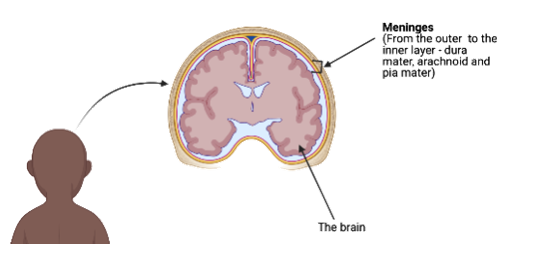What is meningitis?
Most of the time, we will not be aware of the presence of these bacteria and there will be no side effects. Occasionally, however some bacteria cross the blood-brain barrier and invade the meninges where they multiply and cause meningitis. They may also spread to the bloodstream and cause blood poisoning (septicaemia).

Image of the head showing the brain and meninges
Meningitis is a devastating disease and remains a major public health challenge. Together with sepsis, meningitis is estimated to cause more deaths in children under 5 years of age than malaria. Survivors can suffer severe sequelae with considerable social and economic costs. It is important for anyone with symptoms of meningitis to seek medical attention. However, identifying the signs and symptoms of meningitis is difficult as they are quite similar to other medical conditions and its early symptoms start off like flu. Click here to find out more about the symptoms of meningitis.
Risk Factors
The following have been identified as the risk factors that make individuals more vulnerable to meningitis:
- Malnutrition
- Household overcrowding
- HIV infection
- Absence of immunisation
- Indoor air pollution
- Sickle cell disease
- Age
- Living in communal settings
- Immuno-compromised individuals

Population at risk
Meningitis can affect anyone, but there are certain groups of people and certain regions of the world that are at a greater risk of contracting meningitis.
They include the following:
- Children under 5 years
- Teenagers or young adults
- People with weakened immune systems
- The Elderly

Photo by Seth Doyle on Unsplash
Transmission
Most of the bacteria known to cause meningitis can be found in our noses, throats and mouths in a region known as the nasopharynx and oropharynx.

Meningitis can be transmitted from person to person through respiratory droplets as a result of coughing, sneezing and being in close contact with an infected person. The spread of meningitis depends on the cause of the disease and the type of bacteria.
Click below to find out about the different organisms that cause meningitis.
Prevention
Meningitis is a vaccine-preventable disease and the introduction of vaccines has dramatically changed the global burden of disease. Vaccines against meningitis have been proven to be very safe, however, these vaccines are only effective against specific organisms or strains. Visit your nearest health facility to find out about available meningitis vaccines.
Click here to find out more about how vaccines work.












